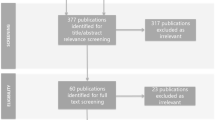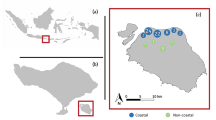Abstract
Environmental restoration projects are commonly touted for their ecological positives, but such projects can also provide significant socioeconomic and cultural benefits to local communities. We assessed the social dimensions of a large-scale coral reef restoration project in Maunalua Bay, O‘ahu, where >1.32 million kg of invasive marine macroalgae was removed from 11 hectares (90,000 m2; 23 acres) of impacted coral reef in an urbanized setting. We interviewed 131 community stakeholders and analyzed both quantitative and qualitative data to assess human uses of the environment, assess perceptions of environmental health, and characterize social dimensions (+/−) associated with the invasive algae removal effort. Results indicate substantial direct economic benefits, including the creation of more than 60+ jobs, benefiting more than 250 individuals and 81 households. The project helped develop a skilled workforce in a local business dedicated to environmental restoration and increased the capacity of community organizations to address other threats to reefs and watersheds. Other major benefits include revitalization of Native Hawaiian cultural practices and traditions and the successful use of harvested invasive algae as compost by local farmers. Our results show the project heightened community awareness and a broader sense of stewardship in the area, creating enabling conditions for collective community action. Our findings show that restoration projects that explicitly incorporate efforts to build community awareness, involvement, and a shared responsibility for a site may ultimately create the long-term capacity for sustainable stewardship programs. We conclude by discussing lessons learned for engaging productively with communities in environmental restoration and stewardship, which remains a central focus in conservation worldwide.





Similar content being viewed by others
References
Barnes-Mauthe M, Arita S, Allen S, Gray S, Leung P (2013) The influence of ethnic diversity on social network structure in a common-pool resource system: implications for collaborative management. Ecol Soc 18(1):23. http://www.ecologyandsociety.org/vol18/iss21/art23/
Bodin Ö, Crona BI (2008) Management of natural resources at the community level: exploring the role of social capital and leadership in a rural fishing community. World Dev 36(12):2763–2779
Bodin Ö, Prell C (eds) (2011) Social networks and natural resource management: uncovering the social fabric of environmental governance. Cambridge University Press, Cambridge
Bos AR, Gumanao GS, Mueller B, Saceda-Cardoza MME (2013) Management of crown-of-thorns sea star (Acanthaster planci L.) outbreaks: removal success depends on reef topography and timing within the reproduction † cycle. Ocean Coast Manag 71:116–122. doi:10.1016/j.ocecoaman.2012.09.011
Brewer T, Cinner J, Green A, Pressey R (2012) Effects of human population density and proximity to markets on coral reef fishes vulnerable to extinction by fishing. Conserv Biol 27:443–452
Brostoff W (1989) Avrainvillea amadelpha (Codiales, Chlorophyta) from Oahu, Hawaii. Pacific Sci 43(2):166–169
Bullock JM, Aronson J, Newton AC, Pywell RF, Rey-Benayas JM (2011) Restoration of ecosystem services and biodiversity: conflicts and opportunities. Trends Ecol Evol 26:541–549
Chan KMA, Goldstein J, Satterfield T, Hannahs N, Kikiloi K, Naidoo R, Vadeboncoeur N, Woodside U (2011) Cultural services and non-use values. In: Kareiva P, Tallis H, Ricketts TH, Daily GC, Polasky S (eds) The theory and practice of ecosystem service valuation in conservation. Oxford University Press, Oxford, pp 206–228
Chan KMA, Guerry A, Klain S, Balvenera P, Satterfield T, Basurto X, Bostrom A, Chuenpagdee R, Gould R, Halpern B, Hannahs N, Levine J, Norton B, Ruckelshaus M, Russell R, Tam J, Woodside U (2012) Where are cultural and social in ecosystem services? A framework for constructive engagement. BioScience 62(8):744–756
Chuenpagdee R, Jentoft S (2007) Step zero for fisheries co-management: what precedes implementation. Marine Policy 31(6):657–668. doi:10.1016/j.marpol.2007.03.013
Cinner JE, Huchery C, Graham N, MacNeil MA (2012) Global effects of local human population density and distance to markets on the condition of coral reef fisheries. Conserv Biol 27(3):453–458. doi:10.1111/j.1523-1739.2012.01933.x
Clark JRK (1977) The beaches of O'ahu. University of Hawai‘i Press, Honolulu
Conklin EJ, Smith JE (2005) Abundance and spread of the invasive red algae, Kappaphycus spp., in Kane‘ohe Bay, Hawai‘i and an experimental assessment of management options. Biol Invasions 7(6):1029–1039
Cordy R (2002) The rise and fall of the Hawaiian Kingdom—a brief overview of Oahu’s history. Mutual, Honolulu
Costanza R, d’Arge R, De Groot R, Farber S, Grasso M, Hannon B, Limburg K, Naeem S, O’Neill RV, Paruelo J (1997) The value of the world’s ecosystem services and natural capital. Nature 387(6630):253–260
Daily GC (1997) Nature’s services: societal dependence on natural ecosystems. Island Press, Washington
Edwards P, Sutton-Grier A, Coyle G (2012) Investing in nature: restoring coastal habitat blue infrastructure and green job creation. Marine Policy 38:65–71
Elliott M, Burdon D, Hemingway KL, Apitz SE (2007) Estuarine, coastal and marine ecosystem restoration: confusing management and science-a revision of concepts. Estuar Coast Shelf Sci 74(3):349–366
Epstein N, Bak R, Rinkevich B (2003) Applying forest restoration principles to coral reef rehabilitation. Aquatic Conserv: Marine Freshw Ecosyst 13(5):387–395
Franklin K (2010) Kamilo Nui could be a cultural resource. Star Advertiser, 18 Aug 2010, Honolulu
Garibaldi A, Turner N (2004) Cultural keystone species: implications for ecological conservation and restoration. Ecology and Society 9(3):1. http://www.ecologyandsociety.org/vol9/iss3/art1
GBRMPA (1995) Controlling crown-of thorns starfish. Great Barrier Reef Marine Park Authority (GBRMPA), Townsville, AU. http://www.reef.crc.org.au/publications/explore/feat45.html
Giddens J, Conklin E, Birkeland C (2012) Experimental removal of roi (Cephalopholis argus) from a Hawaiian coral reef. Progress report. Hawai‘i Coral Reef Initiative, Honolulu
Godwin S, Ku‘ulei SR, Jokiel PL (2006) Reducing potential impact of invasive marine species in the Northwestern Hawaiian Islands marine national monument. Northwest Hawaiian Islands Marine National Monument Administration, Honolulu
Grafton RQ (2005) Social capital and fisheries governance. Ocean Coast Manag 48(9):753–766
Harriott V, Fisk D (1988) Coral transplantation as a reef management option. In: Proceedings of the 6th International Coral Reef Symposium. 6th ICRS Executive Committee, Townsville, Australia, pp 375–379
Kaufman L (2005) If you build it, will they come? Toward a concrete basis for coral reef gardening. In: Coral reef restoration handbook. pp 119–142
Kittinger JN (2013) Participatory fishing community assessments to support coral reef fisheries co-management. Pac Sci 67(3):361–381
Kittinger JN, Finkbeiner EM, Glazier EW, Crowder LB (2012b) Human dimensions of coral reef social-ecological systems. Ecol Soc 17(4):17. http://www.ecologyandsociety.org/vol17/iss14/art17/
Lundquist CJ, Granek EF (2005) Strategies for successful marine conservation: integrating socioeconomic, political, and scientific factors. Conserv Biol 19(6):1771–1778
Marín A, Gelcich S, Castilla JC, Berkes F (2012) Exploring social capital in chile’s coastal benthic comanagement system using a network approach. Ecol Soc 17(1):13
Maunalua Mālama (2009) Maunalua Bay conservation action plan: A community’s call to action. Mālama Maunalua, Honolulu
McGinnis MV, Woolley J, Gamman J (1999) Bioregional conflict resolution: rebuilding community in watershed planning and organizing. Environ Manage 24(1):1–12
Moberg F, Folke C (1999) Ecological goods and services of coral reef ecosystems. Ecol Econ 29(2):215–233
Norström AV, Nyström M, Lokrantz J, Folke C (2008) Alternative states on coral reefs: beyond coral-macroalgal phase shifts. Mar Ecol Prog Ser 376:295–306
Nyström M, Graham N, Lokrantz J, Norström A (2008) Capturing the cornerstones of coral reef resilience: linking theory to practice. Coral Reefs 27(4):795–809
Okimoto D, Friedlander A (2011) Impact on the fishery and diet of ‘ō‘io (bonefish, Albula spp.) in Maunalua Bay, O‘ahu associated with alien algae removal Maunalua Bay Reef Restoration Project, NOAA ARRA Cooperative Agreement NA09NMF4630312, Dec 2011 Final Technical Report, Honolulu
Pandolfi JM, Bradbury RH, Sala E, Hughes TP, Bjorndal KA, Cooke RG, McArdle D, McClenachan L, Newman MJH, Paredes G, Warner RR, Jackson JBC (2003) Global trajectories of the long-term decline of coral reef ecosystems. Science 301(5635):955–958
Pickering H, Whitmarsh D, Jensen A (1999) Artificial reefs as a tool to aid rehabilitation of coastal ecosystems: investigating the potential. Mar Pollut Bull 37:505–514. doi:10.1016/s0025-326x(98)00121-0
Richmond RH (2005) Recovering populations and restoring ecosystems: restoration of coral reefs and related marine communities. In: Norse EA, Crowder LB (eds) Marine conservation biology: the science of maintaining the sea’s biodiversity. Island Press, Washington, pp 393–490
Rinkevich B (2005) Conservation of coral reefs through active restoration measures: recent approaches and last decade progress. Environ Sci Technol 39(12):4333–4342
Rinkevich B (2006) The coral gardening concept and the use of underwater nurseries: lessons learned from silvics and silviculture. In: Precht WF (ed) Coral reef restoration handbook. Taylor & Francis, Boca Raton, pp 291–301
Roberts CM, McClean CJ, Veron JEN, Hawkins JP, Allen GR, McAllister DE, Mittermeier CG, Schueler FW, Spalding M, Wells F, Vynne C, Werner TB (2002) Marine biodiversity hotspots and conservation priorities for tropical reefs. Science 295(5558):1280–1284
Rönnbäck P, Crona B, Ingwall L (2007) The return of ecosystem goods and services in replanted mangrove forests: perspectives from local communities in Kenya. Environ Conserv 34(04):313–324. doi:10.1017/S0376892907004225
Smith JE, Hunter CL, Smith CM (2002) Distribution and reproductive characteristics of nonindigenous and invasive marine algae in the Hawaiian Islands. Pac Sci 56(3):299–316
Smith JE, Hunter CL, Conklin EJ, Most R, Sauvage T, Squair C, Smith CM (2004) Ecology of the invasive red alga Gracilaria salicornia (Rhodophyta) on O’ahu, Hawai’i. Pac Sci 58(2):325–343
Squires D, Vestergaard N (2013) Technical change in fisheries. Marine Policy 42:286–292. doi:10.1016/j.marpol.2013.03.019
Stevens-Gleason A, Hammatt HH (2008) Cultural impact evaluation for the mike horack residential use, single family dwelling project, Wailupe Ahupua‘a, Honolulu District, Oahu Island. Prepared for Hawaii Architects, Inc. by Cultural Surveys Hawai‘i, Inc, Kailua
Thomas F (1995) Excavations at Maunalua Cave, Hawai‘i Kai, O‘ahu. Hawaii Archaeol 4(19):17–26
Urgenson LS, Prozesky HE, Esler KJ (2013) Stakeholder Perceptions of an Ecosystem Services Approach to Clearing Invasive Alien Plants on Private Land. Ecol Soc 18(1). doi:10.5751/es-05259-180126
Ward Research Inc. (2011) Public awareness of invasive algae at Maunalua Bay and its removal: follow-up measure among O‘ahu residents. A report prepared for Malama Maunalua by Ward Research, Inc., Honolulu
Whitmarsh D, Santos MN, Ramos J, Monteiro CC (2008) Marine habitat modification through artificial reefs off the Algarve (southern Portugal): an economic analysis of the fisheries and the prospects for management. Ocean Coast Manag 51(6):463–468. doi:10.1016/j.ocecoaman.2008.04.004
Whyte WF, Greenwood DJ, Lazes P (1989) Participatory action research: through practice to science in social research. Am Behav Sci 32:513–551. doi:10.1177/0002764289032005003
Wiber M, Berkes F, Charles A, Kearney J (2004) Participatory research supporting community-based fishery management. Marine Policy 28(6):459–468
Wilkinson C (ed) (2008) Status of coral reefs of the world: 2008. Global Coral Reef Monitoring Network and Reef and Rainforest Research Centre, Townsville
Wolanski E, Martinez J, Richmond R (2009) Quantifying the impact of watershed urbanization on a coral reef: Maunalua Bay, Hawaii. Estuar, Coast Shelf Sci 84(2):259–268
Woolley JT, McGinnis MV (2000) The conflicting discourses of restoration. Soc Nat Res 13(4):339–357
Young CN, Schopmeyer SA, Lirman D (2012) A review of reef restoration and coral propagation using the threatened genus Acropora in the Caribbean and Western Atlantic. Bull Mar Sci 88(4):1075–1098. doi:10.5343/bms 2011.1143
Acknowledgments
The authors wish to thank the Maunalua community members and participants in this research, without whom this study would not have been possible. A number of key individuals from different organizations contributed greatly to this project. We thank Sean Marrs, David Ziemann, and John Parks from The Nature Conservancy. We also thank Alika Winter, Kimo Franklin, Carol Wilcox, Jennifer Taylor, Dede Mamiya, and Tegan Hammond from Mālama Maunalua, and John Leong, Luke Estes, Lei Leong, and the entire crew and staff of Pono Pacific. We also owe a great debt of gratitude to Laura Thompson, Bruce Blankenfeld, Eugene and Karen Gleason, and other kama‘aina who shared their mana‘o about Maunalua Bay with us, as well as Eric Co, Jason Philibotte, and Russell Amimoto who paved the way for the original community IAR efforts and developed the pakini surveys. Any errors or omissions belong to the authors alone.
Author information
Authors and Affiliations
Corresponding author
Electronic supplementary material
Below is the link to the electronic supplementary material.
Rights and permissions
About this article
Cite this article
Kittinger, J.N., Bambico, T.M., Minton, D. et al. Restoring ecosystems, restoring community: socioeconomic and cultural dimensions of a community-based coral reef restoration project. Reg Environ Change 16, 301–313 (2016). https://doi.org/10.1007/s10113-013-0572-x
Received:
Accepted:
Published:
Issue Date:
DOI: https://doi.org/10.1007/s10113-013-0572-x




